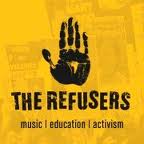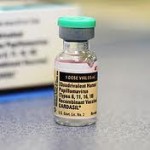By Norma Erickson, President
Listen to more music from The Refusers here.
The first public performance of a now quite
controversial rock band was in July 2010 at the American Rally for Personal
Rights. In the tradition of protest songs during civil rights and anti-war
movements, The
Refusers presented their protest music as a tribute to
vaccine-injury victims past, present and future.
Michael Belkin and his band use a unique musical
style they have dubbed ‘Innoc-You-Rock’ to focus listeners’ attention on
controversial vaccine issues. Their hard-hitting lyrics provide a direct
counterpoint to what they see as “government issued vaccine propaganda and the
current medical establishment’s policy of vaccinate first, ask questions
later.”
The Refusers’ name was chosen in
direct response to the American Medical Association’s position on informed
consent, which says:
“Your patient should have an opportunity to ask questions to elicit a better understanding of the treatment or procedure, so that he or she can make an informed decision to proceed or to refuse a particular course of medical intervention.”
Michael Belkin categorically states, “The AMA’s
position on informed consent does not say ‘except vaccines.’ Vaccination choice
is a fundamental human right. Any doctor who fails to inform you about the risks
associated with vaccines, or who contends you do not have the right to refuse
vaccination is violating their own medical code of ethics.”
What motivated Mr. Belkin to organize his
vaccination protest band?
Flashback fourteen years: Michael is a
successful, self-employed quantitative strategist happily married to the woman
of his dreams. Lyla Rose was born with no complications – a healthy, happy baby
girl. At five weeks of age, she is taken for a check-up and a booster shot of
Hepatitis B vaccine. 15 hours later, Michael’s baby girl was gone.
Michael states that although the coroner
initially stated Lyla’s brain was swollen (encephalitis), the cause of death
ultimately ruled as Sudden Infant Death Syndrome (SIDS). The swollen brain and
the hepatitis B vaccine were not mentioned in the final autopsy report.
Knowing that SIDS is a diagnosis of exclusion and
brain inflammation is not SIDS, Michael’s research began. He discovered the
following quote from Merck’s
Home Health Manual:
Encephalitis can occur in the following ways:
- A virus directly infects the brain.
- A virus that caused an infection in the past becomes reactivated and directly damages the brain.
- A virus or vaccine triggers a reaction that makes the immune system attack brain tissue (an autoimmune reaction).
Michael found himself attending any applicable
government meeting he could. He attended a workshop at the National Academy of
Sciences, Institute of Medicine on “Neo-Natal Death and the Hepatitis B Vaccine”
and an Advisory Committee on Immunization Practices meeting on the safety of the
hepatitis B vaccine. He obtained the entire VAERS database on hepatitis B
adverse events reports and investigated it thoroughly.
In May of 1999, seven months after the tragic
loss of his daughter, Michael Belkin presented the following testimony to
Congress:
Michael continues to work within the system to
promote vaccine safety and preserve the right to vaccine choice for many years.
Although he experiences some small successes, Michael ultimately gets to the
point where he feels he is beating his head against a brick wall. Those in
charge of vaccination rules, regulations and policy-making just do not seem to
care. Tired and wanting to return to a somewhat normal life, Michael takes some
time off from vaccine safety and consent issues.
During his respite, he witnesses the development
and marketing of several additional vaccines. He watches the autism rate climb
to a previously unheard of level. He witnesses a substantial increase in the
size of the VAERS database. He witnesses the increase in chronic and
debilitating diseases in young people throughout the United States.
Michael went on to have two healthy unvaccinated
children. He witnessed apartheid-like exclusionary policies being instituted
against children whose parents chose to try and preserve their health and
well-being. He witnessed people losing their jobs because they decided one
vaccine or another was not in their best interest. He witnessed schools,
daycares, and even medical professionals exclude people based on their
vaccination status.
Michael Belkin decided enough was enough. The
only option left was to take his message to the streets via a medium that might
catch the attention of the average American medical consumer. Michael, his
11-year old unvaccinated son Sebastian, Steve Newton and Joey Walbaum decided to
use their musical talents organize a protest band that would publicly stand up
for everyone’s right to refuse vaccination.
The Refusers take great pride in
their young drummer, Sebastian Belkin – a real deal healthy refuser – and
visible proof that the unvaccinated are not the threat to public health and
safety they are being portrayed as. Sebastian is the epitome of a normal healthy
young man, not to mention talented.
Their strategy appears to be working. The
Refusers first video, shown below, has officially gone viral with over
280,000 views. First Do No Harm, is also the title cut of the band’s
soon to be released CD.
Michael Belkin and The Refusers have obviously
found an effective way to get their message to those who need to hear it.
Listen to more music from The Refusers here.


